
View of the Smithville tornado at maximum intensity. The tornado is directly over town, in the vicinity of Court Street. (surveyormike1 / Youtube)
□ On April 27, 2011, the small town of Smithville, Mississippi, was devastated by one of the most violent tornadoes ever surveyed. Below is a compilation of aerial photographs detailing the first four miles of the EF5 tornado’s damage path. The tornado continued for an additional 34 miles and caused more deaths in Alabama, but the remainder of the tornado’s path was primarily over unpopulated marshland and of lesser intensity. Satellite images of tree damage indicate that the tornado reached maximum intensity soon after touching down and likely weakened not long after exiting Smithville. The NWS report lists 23 fatalities for the tornado’s entire path. With 17 fatalities confirmed in Monroe County and seven deaths reported in Alabama, a death toll of 24 appears accurate.
Click each photo to enlarge.
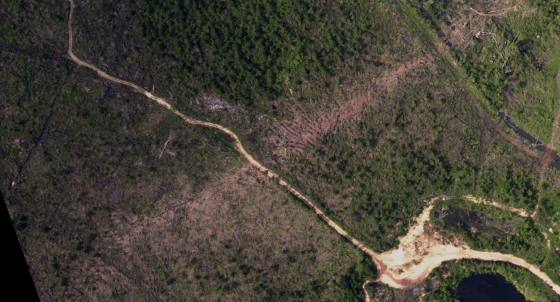
The visible touchdown point of the Smithville tornado was just east of the Tennessee-Tombigbee waterway. The tornado immediately exhibited a narrow core of intense winds (less than 10 yards wide at some points) imbedded within a larger damage swath. The tornado intensified extremely rapidly and was likely powerful enough to level a home within seconds of touchdown.
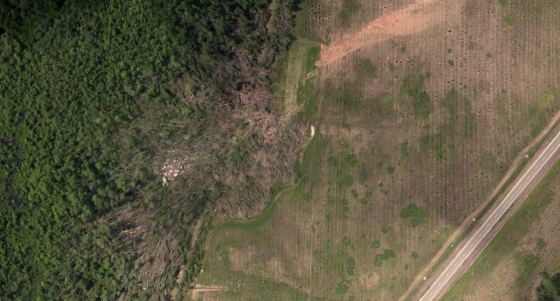
The tornado reorganized two miles southwest of Smithville and briefly left a trail of intermittent damage with several distinct damage swaths. A narrow, intense vortex abruptly developed at the edge of a wooded area (seen just left of center) and continued all the way through Smithville. Within seconds, the narrow wind feature was powerful enough to leave deep scouring marks in a field. This is an indication of EXTREME intensity.

Close up view of deep ground scouring. Up to 12-inches of topsoil was removed. Scouring patterns were of continuous but varying severity for the next two miles.

A gas station that had been converted into an apartment building was swept cleanly away, leading to the tornado’s first fatality. Three unoccupied mobile homes nearby were obliterated. A large freight rig that had been parked in the apartment’s dirt driveway was torn apart and hurled approximately 200 yards to the northeast (the NWS page incorrectly estimates the rig was thrown 1/4 to half a mile). Vehicles throughout the tornado’s path were thrown long distances, many more than half a mile.
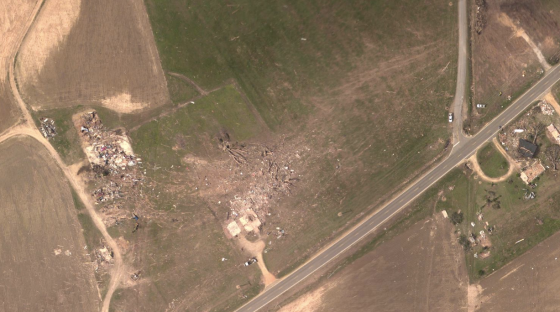
The Smithville tornado paralleled Highway 25 (soon to be called Main Street) and directly encountered its first well-constructed home 1.5 miles after touchdown. The home was swept away in EF5 fashion and grass was scoured from the ground. The EF5 damage path was about 30 yards wide. Lighter damage occurred over a larger area approximately a quarter mile in width.
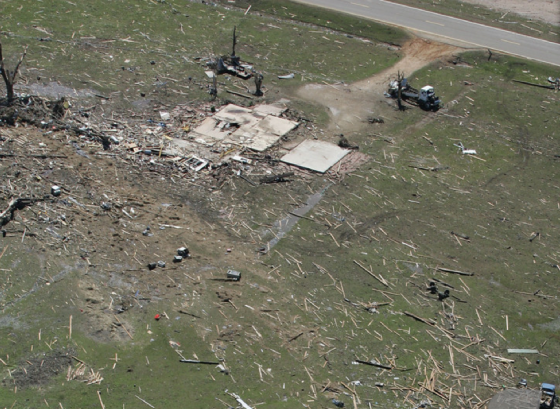
Closer view of the brick home devastated by the rapidly intensifying tornado on Highway 25. The owner of the home, Mr. Jessie Cox, was among the tornado’s victims. Grass around the home was scoured from the ground, leaving behind a muddy aftermath common to intense EF5 tornadoes. (Thomas Wells)

Wind damage was far more expansive to the south of the tornado’s center. This was the result of the tornado’s rapid forward speed, which added significant momentum to the storm’s right half. The narrow path of the tornado’s inner core is marked by the scoured grass to the north of Main Street (upper left corner). Six more people were killed in homes that were swept completely away along Highway 25. A survey team later concluded that “in the core of the tornado, you had to be underground or in a safe room to survive” (Hayes, 2011).

Two views of the damage track through Smithville. The streak of EF5 damage was narrow and clearly defined, but the visible funnel expanded beyond the town’s two water towers. A truck parked at a residence near Young Street (the close foreground in the right image) was thrown so far that it remained missing at the time of the damage survey (NWS, 2011). (Right side image by JJ Jasper)

Moving at 70mph, the tornado took only seconds to sweep two large, well-constructed brick homes from their foundations. Nearby, a grove of large hardwood trees was obliterated. The intense inner core shifted away from Main Street and raced into a neighborhood north of Smithville’s business district. The EF5 damage was confined to a narrow corridor, but moderate to severe damage spread several blocks to the south. Extensive wind rowing is evident – a damage feature unique to the most violent of tornadoes.

Close view of a destroyed brick home visible in the previous image. The body of the home owner was found in a field to the northeast. Small shrubs and vegetation near the foundation were shredded and pulled from the ground, an indication of intense tornado-ground interaction. Most other E/F5 tornadoes that have caused similar damage, such as the Bridge Creek storm of 1999, were larger and significantly slower moving than the Smithville tornado. One town resident, who witnessed the tornado from the Smithville Telephone Company, described the tornado as a “black swirling mass” that “moved so fast it was unbelievable.”

A red SUV was hurled a half mile through the air before impacting the top of the 130ft Smithville water tower, leaving a visible dent. The vehicle was then thrown an additional quarter mile before coming to rest at the end of Cemetery Drive. Photographs indicate the SUV was crushed into a ball only a few feet across.
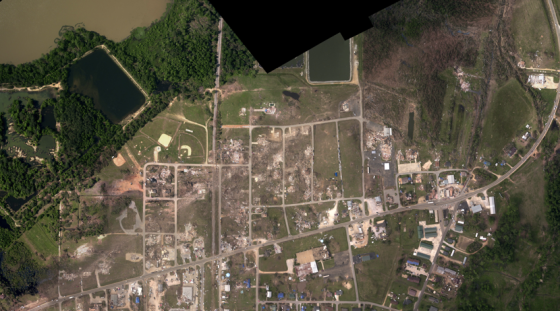
Wide view of the tornado’s path through the northern section of town. The streak of EF5 damage was imbedded within the tornado, which enveloped nearly all of the buildings visible above. There were 16 fatalities in Smithville, a remarkably low figure in relation to the number of buildings that experienced EF5 damage. The low death toll is attributed to the fact that the tornado struck in the middle of a workday when many of the homes were vacant.
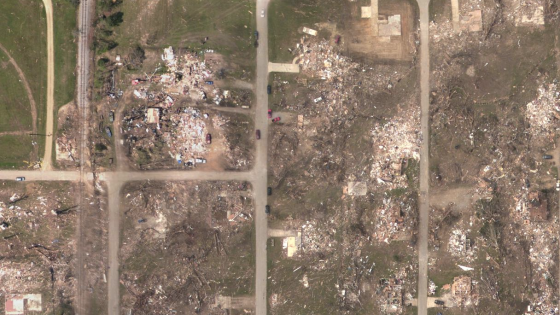
Multiple instances of EF5 damage between Monroe and Maple Street. Survivors reported that the fast moving tornado lasted less than ten seconds. Pronounced ground scouring is visible within the center of the damage track. Most of the giant hardwood trees that decorated the area were snapped just above ground level. A section of missing road can be seen on Market Street (at left center) near the railroad tracks. While initially reported as tornado damage, a later report indicated the road was purposefully demolished in order to deter traffic over the damaged culvert (Knupp and Laws, 2012).

Close aerial view of the narrow streak of extreme destruction near Market Street. The tornado passed through the “nicest section of town”. Two brick homes once shared a backyard to the left of the large tree trunk at center. Calculating the tornado’s forward speed and the width of the EF4+ damage track indicates peak winds lasted less than three seconds. (Thomas Wells)

The businesses along Main Street suffered severe damage despite being outside the tornado’s inner core. A Piggly Wiggly supermarket (large building at bottom center) was gutted by violent inflow winds. Farther north, a cluster of mobile homes was swept away in the core damage path, causing one death. The twisted frames of several mobile homes were thrown a half mile and found wrapped around debarked trees to the east of Cemetery Drive. Fortunately, it appears that, with the exception of the single fatality, none of the other residents on the block were home at the time.
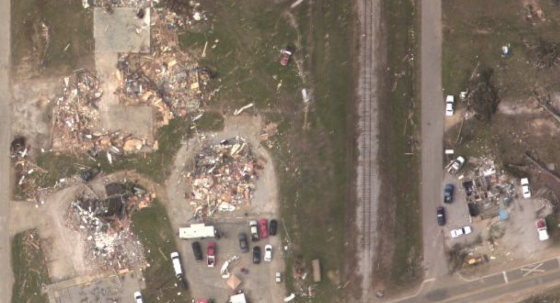
Close view of buildings along Main Street. A large, two-story brick column post office (bottom left) collapsed with several people inside, all of whom survived. A neighboring business to the north was reduced to a concrete slab. Surveillance cameras at the Smithville police station (bottom right) captured the only known footage of the tornado from within town. One survivor on Main Street described the tornado as a quick “blast of air” from the southwest, like “a nuclear shock wave”, that flattened all of the buildings at once.
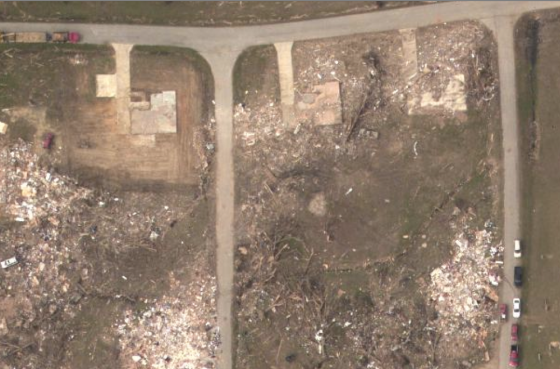
Three large, well-constructed homes with extensive foundation anchoring were reduced to bare slabs. Surface vegetation was scoured from the ground.

Two views of catastrophic home damage. The image at right shows the complete destruction of several large homes on Elm Street. A two story brick home (center right) was swept so completely away that even the sill plates appear to have been pulled from the foundation. At left are the remains of two well-constructed homes (visible in the previous photograph) before any clean-up had commenced. Grass scouring is evident near the foundations. (Thomas Wells)

Wide aerial view of the swath of EF5 damage. Seven additional fatalities occurred east of the railroad tracks between Earl Frye Street and Cemetery Drive. There were no survivors in the three obliterated homes on Monroe Street (visible at left center). Before the tornado struck, the city built an extension of Monroe Street using gravel and tar in order to build new houses (visible at bottom center). The tornado blew the exposed tar (not pavement) from the street, leaving bare soil underneath.
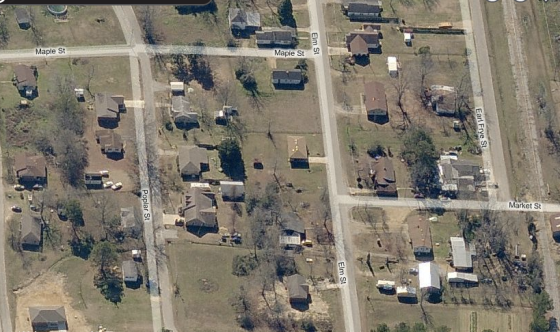
South facing view of homes along Elm Street and Poplar Street before the tornado. Most of the residences in the area were old one and two-story homes, some of which were well anchored to their foundations. (Bing Maps)
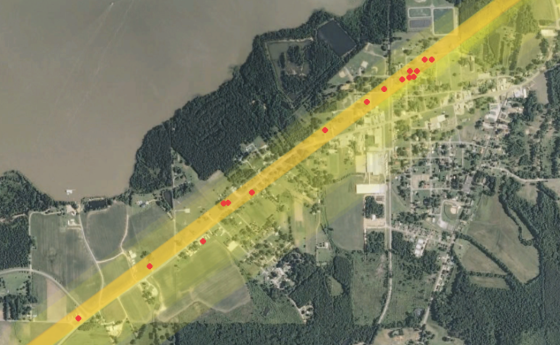
Map of the tornado’s path through town and the location of each fatality (there were two homes where two fatalities occurred – both marked by connected dots). The swath of EF5 damage is highlighted in light orange. Only one death occurred outside the narrow zone of extreme damage – a young women was killed in a trailer on the south side of Highway 25.

A large funeral home was swept cleanly away as the tornado exited town and entered a forested area. The building was empty when the tornado struck, preventing the death toll from climbing even higher. Pulverized vehicles, utility poles, and debris from across town were left strewn among the debarked trees.

A wide view of damage on the east side of Smithville. The tornado’s complex wind distribution is visible through the damage patterns in the forest. Several large, re-inforced brick buildings (bottom center) experienced EF3 and EF4 damage well outside of the worst affected areas. The Smithville Baptist Church was nearly leveled by a rush of westerly winds that hurled cars into the building’s few remaining walls.
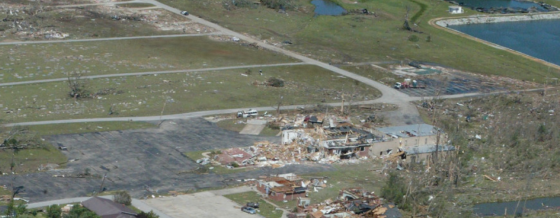
Close aerial view of the tornado’s path as it crossed Cemetery Drive. Grass scouring marked the narrow path of extreme winds. Smithville experienced the most intense tornado damage of all the populated areas affected during the 2011 Super Outbreak. (Thomas Wells)

The tornado may have weakened slightly as it passed north of Smithville High School, but winds likely remained in the EF5 range for several additional miles. In the area above, the tornado debarked and flattened a narrow section of pine forest. Southern pines are extremely flexible and durable, but they were no match for winds over 250mph.
*A special thank you to Smithville resident Darnell Collums for her assistance.
(Any Monroe County residents or others who directly experienced the EF5 tornado or its aftermath are asked to contact me at extremeplanetmax@gmail.com.)

Really intense! How selective the damage can be. Can you mark the first few pictures with an arrow or something so it is easier to recognize the tornado path?
Pingback: The Indefinitive List of the Strongest Tornadoes Ever Recorded (Part I) | Extreme / Planet
You did a good job of putting the pictures up. I lived thru this tornado and am still finding pictures on the web that I had not seen before. Scariest few minutes of my life.
Darnell – if you’re from Smithville, then it’s awesome to be talking to another survivor of this tornado! I’ve talked to a few people from the area via e-mail, and am doing the best I can to make sure I’m properly identifying all of the locations and buildings. Google Earth has been no help. If you see any mistakes (particularly in regards to the building that was swept away at the end of Cemetery Drive, which I believe was a funeral home) then let me know.
Yes it was our funeral home. I was at work which was across HWY 25 from Cemetery Dr. We had major damage to our buildings. I can send you some pictures that I made if you want to see them.
If you have any pictures I would love to see them! The Smithville tornado was one of the most impressive in history, and I have plenty of aerial photographs, but not many ground level views. E-mail me at extremeplanetmax@gmail.com, or give me your contact info.
I sent you some pictures to you gmail account yesterday. Hope you get them.
What an incredible tornado. Google Street View shows a lovely little town before this monster scraped everything up. Sad to see the result. B
By the way, is it “Merchant Street” or “Market Street” where the underground pipe was pulled up?
Francis – Thank you for bringing that to my attention. Market Street is the correct name. Not sure how I made that mistake so consistently.
Click to access sels12b.pdf
A few interesting details about Smithville (along with most of the outbreak’s violent tornadoes) not sure of the validity of all of them, just thought they might interest you.
Wow, excellent article. I have to believe that their statement on the damage to Market Street is correct, so I will change that accordingly.
The picture and accompanying text for the storm shelter, how it almost heaved out of the soil and just barely held really made me shiver at what could have happened if the wind gusts were a couple mph faster.
You mention a small, intense core with this tornado and the 2013 Moore tornado. Is such a core why some tornadoes such as the one in this video appear to have two concentric funnels? Or does that relate more to roping out?
Note: the tornado I was referring to is around the 3:20 mark. Apparently the t= thing doesn’t work with embedding.
It is hard to believe that it took only 205mph winds to cause this type of damage. The Smithville tornado was listed by NWS as 1/2 to 3/4 mile wide and had a peak wind of 205mph. Looking at the aerial views I would think it would take at least 250mph winds to do the type of damage this tornado did. Any thoughts on that.
Nick – the tornado depicted appears to be roping out, as you say, but still shows the same basic idea despite being far smaller, weaker and more transparent than Smithville.
Shane – I believe every tornado given an EF5 rating since 2008 has had winds well over 210mph. The Smithville tornado was EXTREMELY violent and surely had brief gusts well over 250mph.
Sort of a weird question, but would you mind telling me where you acquired all these aerial pictures from April 27?(specifically the ones that show the Rainsville damage, and the Smithville/Cordova scouring). I’m really interested in examining the individual tornado tracks myself. Any help would be great.
Also instead of posting it here you can email it to me as well.
If Smithville only had brief gusts over 250mph why is it listed ahead of the 1999 Oklahoma Tornado on your top 20?
I think the Smithville tornado had gusts well over 250mph. My estimates are far above the EF-Scale’s confines, but I’d say just over 300mph for a brief moment. The Smithville and 1999 OKC tornadoes caused comparable home and vegetation damage, but the Smithville tornado’s extreme winds lasted for a much shorter period of time.
The Smithviile tornado got me thinking about something, have tornadoes touched down instantly as F5/EF5 before? Or is Smithville as close to anything as we have come?
Randy – I don’t know if a tornado has ever become an EF5 instantly, but some have very rapidly intensified to EF4 intensity in the first half-mile. I wrote about an unusual anticyclonic tornado in another post – “Fascinating tornado records” – that caused F4 damage immediately upon touchdown. The Smithville tornado reached EF5 intensity faster than any other tornado I can think of.
When it is reported vehicles were “thrown a half mile” is this an accurate statement or were they carried aloft in the tornado for a distance and then eventually tossed a shorter distance? I know a vehicle was “thrown” from the Smithvile Ef5 reportedly a half mile leaving a dent in a water tower, is it possible the vehicle grazed the tower while aloft and was then thrown?
The second part is I would love to see an article examining the physics behind such incredible feats, ie height, velocity required to move object (vehicle) “x” amount of distance and if there is such a study then would it not put to rest the debate on what the wind speed in these tornadoes are capable of producing? It seems like an easy solution to an answer, physics don’t lie. Great stuff, thanks!
Jason, Ontario, Canada
I love a good article. Great post!
What is wind rowing and how is it different from scouring? Thanks